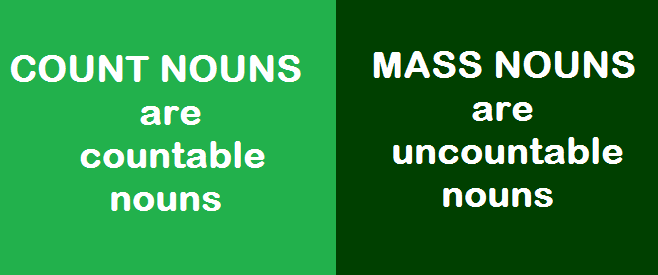On Count Nouns and Mass Nouns
We English speakers are sometimes surprised to discover that we split our perspective on how we view things in the universe. As it turns out, we make a clear distinction between count nouns and mass nouns.
Count nouns are – not surprisingly – nouns you can count: one book, two books, three books, and so forth.
Mass nouns are nouns you cannot count, like hope. There is no such thing as one hope, two hopes, three hopes.
You can tell the difference between count nouns and mass nouns by the way we talk about them.
The question: How many books are there? yields the response: There are very many or very few.
The question: How much hope is there? yields the response: There is very much or very little.
Now, here’s what’s weird (or cool). In Vietnamese all nouns are mass nouns, as they are in Chinese (Mandarin, Cantonese, etc.), Japanese, Korean, Malay and Thai. I have a Korean colleague at Duke who has told me she sometimes has to pause to consider whether the noun she is talking about in English is mass or count.
In East and Southeast Asian languages, when you want to count a noun or particularize it in some way by using the demonstrative this or that, you have to add a classifier. If you’re counting shirts, you have to add the clothing classifier. If you’re counting books, you have to add the books/printed matter classifier.
In Vietnamese:
mot cái áo = ‘one shirt’
mot = ‘one’ and áo = ‘shirt’ plus the classifier cái
hai quyên sách = ‘two books’
hai = ‘two’ and sách = ‘book’ plus the classifier quyên
When learning a language with numeral classifiers, Chinese for instance, your teacher may tell you that if you don’t know the proper classifier or have forgotten it, it is better to insert the most common classifier gè into whatever you are counting rather than nothing at all. The lack of any classifier will be confusing to a Chinese speaker.
Classifier languages tend to have between 20 and 200 classifiers, and they almost always involve the size and/or shapes of the noun particularized.
Guess what? English has classifiers.
Piece of is the default classifier that particularizes many mass nouns such as luggage, gum, gossip, ass, news, furniture and pie (understood as an individual pie; separate pies can be counted, of course).
An example of an obligatory classifier in English exists for the restricted set of mass nouns: golf, applause, violence, government measures (e.g. taxes, funding cuts, etc.) and drinks (in the sense of group participation). When particularized by a number, the indefinite article a, or the adjective another, these nouns require the classifier round of to be used.
In other words, no one says “I normally play two golfs” or “I’m going to play another golf.”
Games in general in English are viewed as mass nouns.
We either “play tennis” or “play a game of tennis” but we do not “play a tennis.”
Here’s another weird (cool) thing: in a European language like Romanian you can say
joc un tenis = ‘I play a tennis‘
with the clear meaning ‘I’m playing a game of tennis.”
Romanians also do not make the same grammatical distinctions English speakers make with respect to count v. mass nouns (many/few v. much/little). All Romanian nouns are treated the same way when compared.
Romanians also sometimes view as count nouns what English speakers view as mass nouns.
N’am nici un ban in buzunarul meu = ‘I don’t have a cent in my pocket.’
Am multi bani in buzunarul meu = ‘I have a lot of money in my pocket.’
So, ‘cent’ pluralized is the count noun ‘money’ in Romanian, whereas it’s a mass noun in English.
Similarly, apa ‘water’ in Romanian is a count noun and has the plural ape which might be seen on a sign in a grocery store corresponding to what in English would be the mass noun Water aisle/section.
European languages do have what could be called classifiers. Take French and the mass noun neige ‘snow.’ In order to particularize it French speakers say:
un flocon de neige = ‘a flake of snow’
However, my point here is two-fold:
1. French and Romanian have a gender system for their nouns. In French they’re either masculine or feminine; in Romanian they’re either masculine, feminine or neuter. If you already have your nouns in gender categories, you don’t need to sort them out again in terms of mass v. count.
It’s grammatical anatomy. Just as no animal has both shoulder blades and wings, no language has both a gender system and a classifier system.
2. Old English (500 – 1100 AD) had the 3-way gender system common to all Germanic languages and lost it during the Middle English period (1100-1500 AD). What has happened in the intervening 500 years is the rise of the classifier system. Today, English, the only European language without a gender system, has a more elaborated classifier system than any other European language.
See also: Language Blogs
Categorised in: Language
This post was written by Julie Tetel Andresen
You may also like these stories:
- google+
- comment



